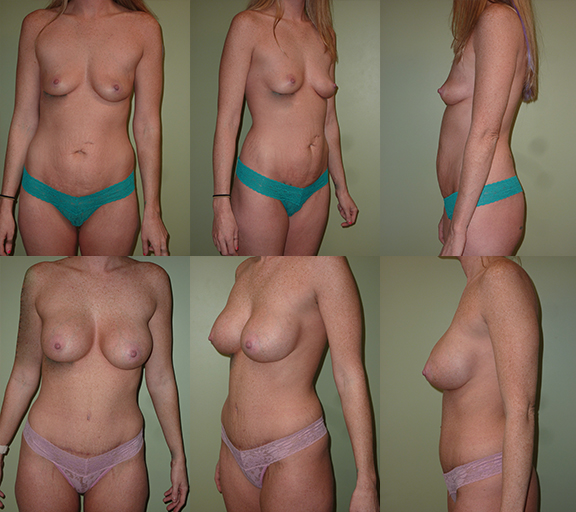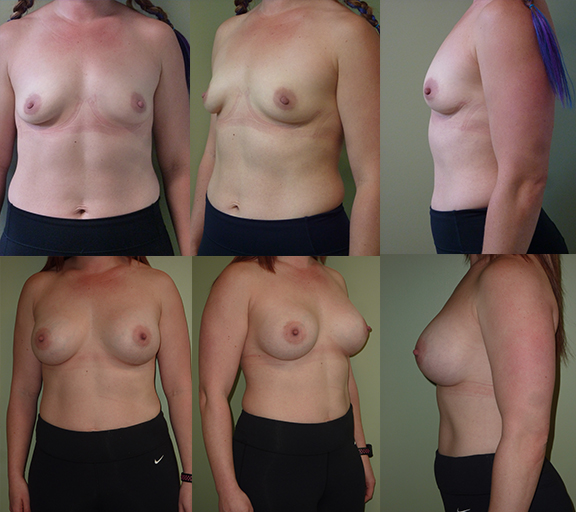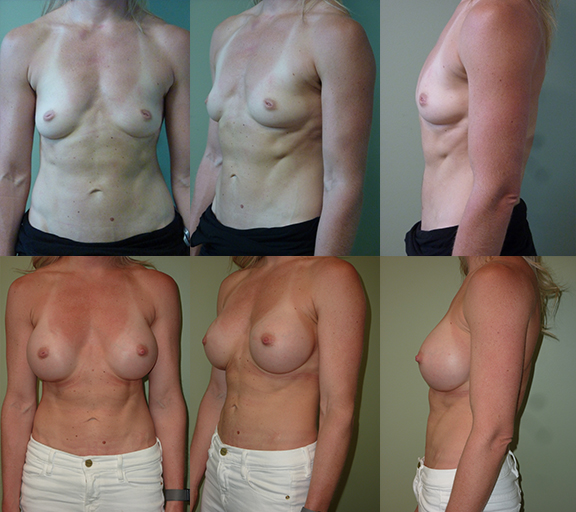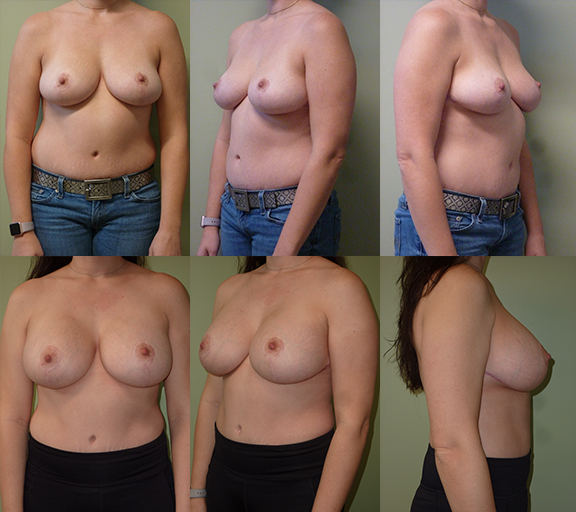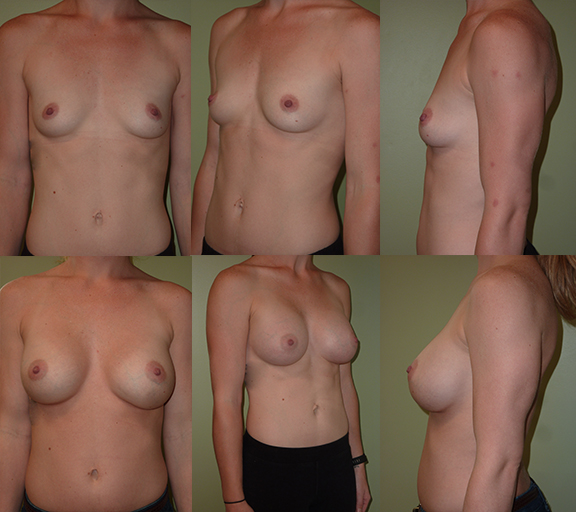New England’s Leading Breast Implant Procedures
Breast augmentation is known by several other names, including augmentation mammaplasty, breast enlargement and breast implants. It is one of the most commonly performed procedures performed by plastic surgeons today, and involves the use of implants to improve the contour of your breasts. There are many reasons women undergo augmentation including loss of volume after pregnancy or weight loss, or simply to fulfill your desire for larger breasts, or provide balance to your physique. The majority of women have some unevenness in the size or position of their breasts, and implants can be very helpful in correcting this asymmetry. Whatever your reason for choosing breast augmentation, you can be confident that it will enhance your natural beauty and improve your self-confidence.
There are several questions you may ask yourself prior to deciding if breast augmentation is right for you. It can be a mistake if a plastic surgeon considers the procedure a routine or one-size-fits-all operation. On the contrary, it is a procedure that is tailored specifically to your breast and chest dimensions, as well as, to the size you desire. The before and after photos that are provided demonstrate a wide variety of breast sizes and shapes so that you can get a sense of the broad range of excellent results that are possible. If you have mild breast sagging (also called ptosis), implants can help improve this, although more severe drooping may require a breast lift (also known as mastopexy). These procedures can be combined in many cases to not only give you larger breasts but also restore a more youthful appearance to your chest.
The Consult
Breast augmentation consultations are a two-step process. For your first visit you will meet with one of our medical staff who has been working with Dr. Sterling for over 11 years and is very knowledgeable in the assessment of patients. These appointments are scheduled on Fridays and the consultation fee is $125. When you schedule your procedure, the $125 fee is deducted from the cost of the surgery. During this initial consultation you will have the opportunity to undergo sizing, have the procedure explained, as well as, have all of your questions answered in a relaxed atmosphere. After this visit, an appointment is then scheduled for a consultation with Dr. Sterling. By the time the patient comes in for their appointment with Dr. Sterling they have a good understanding of the proposed surgery and the expected outcome. Dr. Sterling will review the initial consultation and answer any remaining questions before examining you and finalizing the plan for your surgery. Consultations with Dr. Sterling are scheduled on Mondays and Wednesdays. Dr. Sterling performs surgery on Tuesdays and Thursdays.
Breast augmentation is a purely elective surgical procedure which means that it is only performed if you are in good health. A full history and focused physical examination is performed at the time of your consultation with the doctor, and clearance from your regular physician is required prior to proceeding with surgery. Safety is our primary concern in aesthetic surgery and we take every precaution to ensure an excellent outcome.
Together we discuss the details of the procedure and determine the proper size and type of implant. Most women are opting for silicone implants nowadays, but saline implants can still give beautiful, natural results in most cases. Almost all implants are placed in a subpectoral position (under the muscle) to provide a more natural appearance, protect from bottoming-out, and to lessen the risk of capsular contracture. Preoperative photos of your breasts will be taken to be part of your chart and remain completely confidential. Once you are satisfied that all of your questions have been answered the process of scheduling your breast augmentation can begin.
Before & After Breast Augmentation Gallery
FAQ
The two types of implants used today are saline and silicone. There are also different shapes, including tear-drop (called anatomic) and round; and both smooth and textured. The vast majority of implants used for cosmetic purposes are smooth, round implants either silicone or saline. There are very specific indications for using the other types and that may be determined at your consult.
Saline implants are filled with sterile salt water that is injected into the implant after it has been placed in the pocket at the time of surgery. It is very important to properly fill the implant to ensure a natural look and feel to the breast. In the case of leakage or rupture, the body absorbs the saline harmlessly and the deflation is easily noticeable.
Silicone implants are filled with a polymeric gel of the element silicon which we all naturally have small amounts of in our bodies. The FDA has approved these implants for use in women 22 years of age and older, after many years of exhaustive studies proved that they cause absolutely no harm to women. Silicone implants may be used in younger women if the surgeon determines that a significant asymmetry or abnormality exists. Implant rupture may be harder to detect and could require an ultrasound or MRI to make the determination. Even so, the gel remains in the pocket that your body creates around the implant and is not dangerous. To read more about saline vs silicone, visit our saline vs silicone page.
All breast augmentation is done under general anesthesia which is exceedingly safe. The public perception of anesthesia being dangerous was from a previous era when the current drugs and practices weren’t available. For healthy individuals, general anesthesia carries virtually the same risk as sedation. All of my patients are administered anesthesia by experienced MDs at a brand new facility with the latest and safest equipment.
The two most commonly performed incisions are through the fold under the breast (called the inframammary fold) and around the nipple (periareolar). Other approaches are in the armpit (axillary) and belly button (umbilical). Approximately 95% of my augmentations are done via the fold incision as it provides the best visualization and a highly acceptable scar that is hidden by a bikini top. If you have very small breasts, a periareolar incision may be preferable and gives the exact same results. I do not perform the armpit and belly button approaches because I feel that they don’t provide the same consistently excellent and reliable results that I achieve with the others.
Placing the implants behind the muscle provides multiple advantages including protection from capsular contracture, more accurate mammography, better coverage and camouflage of the implant, and protection from bottoming out. If adequate breast tissue is present, the implant will be well-disguised regardless of being placed above or below the muscle. Also, since silicone implants are used almost exclusively again, subglandular implants provide much more consistent and excellent results. Implants placed above the muscle is also called subglandular or suprapectoral augmentation. It is an excellent choice that can provide superior results when properly indicated. Indications for subglandular augmentation include minimal ptosis, bodybuilding or fitness models that pose while flexing, desire to avoid a breast lift or personal preference. The most common indication for implants above the muscle is bodybuilders that are posing and are bothered by movement of the implant while flexing. There is a slightly higher risk of capsular contracture but the risk is still approximately only 10%.
Below you will see listed the risks/complications that are possible. The thing to keep in mind, however, is that the chance of having any of these problems is exceedingly low in my practice.
- Bleeding
- Infection
- Hypertrophic scarring
- Capsular contracture (see separate article describing)
- Altered nipple sensation (usually increased early)
- Implant rupture or leakage
- Rippling (usually due to improperly filled implants)
- Implant malposition
- Deep vein thrombosis (blood clots in the legs)
- Need for revisional surgery
- Cardiac or pulmonary complications
Implants are not permanent and will need to be replaced at some point. Most implants will last a minimum of 20 years however. The rupture rate is roughly 10% at twenty years which is very acceptable. Excellent warranties are provided by the two implant manufacturers which cover almost the entire cost of replacement surgery and also provide for free implants. You can rely on the fact that your results will be long-lasting and it should be many years before you need to consider any revisional surgery.
The amount of pain you experience is somewhat subjective, but the majority of women have mild to modest discomfort. Long-lasting local anesthetic is injected into the breast pocket at the time of surgery which provides extended relief during the period of most pain, which is the first evening. You are provided with prescriptions for narcotics to provide relief during the first several days after your operation. Beginning ibuprofen (Advil, Aleve, Motrin) the evening of surgery usually allows discontinuation of the narcotics by the second day. I have performed hundreds of breast augmentations both with and without pain catheters left in at the time of surgery, and it is my opinion that the difference in pain levels is minimal. If you prefer the use of pain catheters it can be arranged. We also provide mild sedatives which I encourage you to take the night before surgery to ease any anxiety that you might be experiencing. The key to excellent control of pain and anxiety is never allowing it to become significant in the first place!
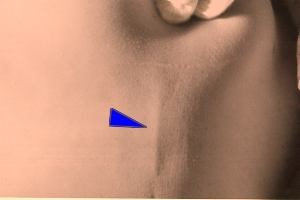 Mondor's Cords are firm cord-like bands that sometimes form just under the skin near the breast. One or more cords may appear. They are completely harmless and affect a small percentage of women. They can be painful and usually begin 1 to 4 weeks following surgery. Warm compresses and anti-inflammatories such as ibuprofen help to alleviate the discomfort. They will eventually go away in a month or two.
Mondor's Cords are firm cord-like bands that sometimes form just under the skin near the breast. One or more cords may appear. They are completely harmless and affect a small percentage of women. They can be painful and usually begin 1 to 4 weeks following surgery. Warm compresses and anti-inflammatories such as ibuprofen help to alleviate the discomfort. They will eventually go away in a month or two.
As I mentioned above, I have performed hundreds of breast augmentations and breast procedures are a large part of my practice. I had the opportunity to operate with many surgeons during my training and in doing so developed my own style which incorporates the best of all approaches. In addition to breast augmentation I perform breast reduction, mastopexy (breast lift), nipple-areolar reduction, and inverted nipple correction, as well as many other breast-related procedures.
I prefer that my patients stay active and in fact require that you are up and walking around the evening of surgery. Light exercise can begin after several days, not including chest-specific weight training though. All restrictions are removed after six weeks, and sometimes even earlier depending on your personal progress. It is important to follow all instructions during the early postoperative period to ensure excellent results. I always remind my patients that they went through the effort to have the surgery and to give themselves the proper time to recover.
You arrive at the facility approximately an hour prior to your scheduled time of surgery. The skilled nursing staff greets you and takes you to a private room in the preoperative area where you change and complete the admission process. You then meet your anesthesiologist who reviews your history with you and explains the procedure of going to sleep and waking up in the most comfortable and safe way possible. I arrive shortly thereafter to mark you for your surgery and answer any last minute questions that you might have. You receive a single dose of intravenous antibiotics as prophylaxis against infection and are then taken into the operating room where you comfortably drift off to sleep and wake up 45 minutes later with your new implants in place. After a short time in the recovery room you are taken back to the private room where you began before surgery. Your nurse then reviews the postoperative instructions that we provided you with and gets you ready for discharge usually within two hours of leaving the operating room. You can expect a call from me that evening to make sure that you are doing well. Remember, my phone number is provided to you and is on 24/7 for my patients.
You are seen in the office the day after your surgery so that one of our medical staff can review your exercises with you to help initiate implant mobility and soften the pocket. I see you multiple times out to at least one year following your surgery, and anytime after that if you desire. My goal is to provide excellent and long-lasting results in a practice that is always there for you.
Silicone implants are filled with a polymeric gel of the element silicon which we all naturally have small amounts of in our bodies. The FDA has approved these implants for use in women 22 years of age and older, after many years of exhaustive studies proved that they cause absolutely no harm to women. Silicone implants may be used in younger women if the surgeon determines that a significant asymmetry or abnormality exists. Implant rupture may be harder to detect and could require an ultrasound or MRI to make the determination. Even so, the gel remains in the pocket that your body creates around the implant and is not dangerous.
To learn more about the implants we use, please visit our implants page by clicking here.
